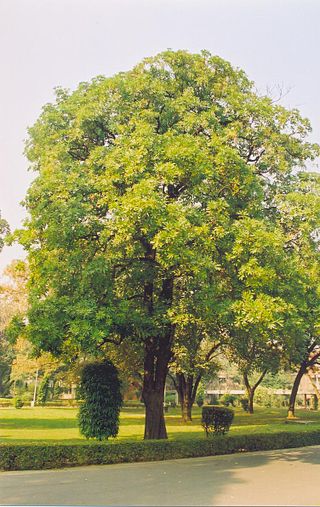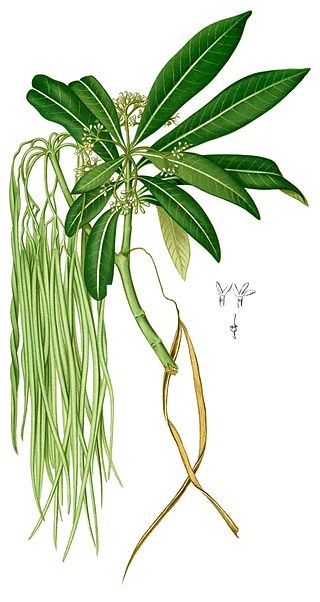
Apocynaceae is a family of flowering plants that includes trees, shrubs, herbs, stem succulents, and vines, commonly known as the dogbane family, because some taxa were used as dog poison. Members of the family are native to the European, Asian, African, Australian, and American tropics or subtropics, with some temperate members. The former family Asclepiadaceae is considered a subfamily of Apocynaceae and contains 348 genera. A list of Apocynaceae genera may be found here.

Alstonia is a widespread genus of evergreen trees and shrubs, of the family Apocynaceae. It was named by Robert Brown in 1811, after Charles Alston (1685–1760), professor of botany at Edinburgh from 1716 to 1760.

Alstonia scholaris, commonly called blackboard tree, scholar tree, milkwood or devil's tree in English, is an evergreen tropical tree in the Dogbane Family (Apocynaceae). It is native to southern China, tropical Asia (mainly the Indian subcontinent and Southeast Asia)and Australasia, where it is a common ornamental plant. It is a toxic plant, but is used traditionally for myriad diseases and complaints.

Alstonia macrophylla, the hard alstonia, hard milkwood or big-leaved macrophyllum, is a species of plant in the family Apocynaceae.
The IUPHAR/BPS Guide to PHARMACOLOGY is an open-access website, acting as a portal to information on the biological targets of licensed drugs and other small molecules. The Guide to PHARMACOLOGY is developed as a joint venture between the International Union of Basic and Clinical Pharmacology (IUPHAR) and the British Pharmacological Society (BPS). This replaces and expands upon the original 2009 IUPHAR Database. The Guide to PHARMACOLOGY aims to provide a concise overview of all pharmacological targets, accessible to all members of the scientific and clinical communities and the interested public, with links to details on a selected set of targets. The information featured includes pharmacological data, target, and gene nomenclature, as well as curated chemical information for ligands. Overviews and commentaries on each target family are included, with links to key references.

Boonein is an iridoid isolated from Alstonia boonei, a medicinal tree of West Africa.

Loganin is one of the best-known of the iridoid glycosides. It is named for the Loganiaceae, having first been isolated from the seeds of a member of that plant family, namely those of Strychnos nux-vomica. It also occurs in Alstonia boonei (Apocynaceae), a medicinal tree of West Africa and in the medicinal/entheogenic shrub Desfontainia spinosa (Columelliaceae) native to Central America and South America.

Echitamidine is an indole alkaloid isolated from Alstonia boonei. Its laboratory synthesis has been reported.

Nareline is a bio-active alkaloid isolated from Alstonia boonei, a medicinal tree of West Africa.

Picrinine is a bio-active alkaloid from Alstonia boonei, a medicinal tree of West Africa.

Scholarine is an alkaloid isolated initially from Alstonia scholaris by Banerji and Siddhanta. Subsequently, it was obtained from the West African tree Alstonia boonei. The derivative N-Formylscholarine has been isolated from the fruit pods of Alstonia scholaris.

Pseudoakuammigine is a bio-active alkaloid from Alstonia boonei, a medicinal tree from West Africa.

Rhazine is an alkaloid isolated from Alstonia boonei, a tree of West Africa.

Scholaricine is an alkaloid that has been isolated from Alstonia boonei, a tree of West Africa.

Alstonine is an indoloquinolizidine alkaloid and putative antipsychotic constituent of various plant species including Alstonia boonei, Catharanthus roseus, Picralima nitida, Rauwolfia caffra and Rauwolfia vomitoria. In preclinical studies alstonine attenuates MK-801-induced hyperlocomotion, working memory deficit and social withdrawal. It also possesses anxiolytic-like effects in preclinical studies, attenuates amphetamine-induced lethality and stereotypy as well as apomorphine-induced stereotypy, and attenuates haloperidol-induced catalepsy. These effects appear to be mediated by stimulation of the 5-HT2C receptor. In addition, alstonine, similarly to clozapine, indirectly inhibits the reuptake of glutamate in hippocampal slices. Unlike clozapine however, the effect of which is abolished by the D2 receptor agonist apomorphine, alstonine requires 5-HT2A and 5-HT2C receptors to produce this effect, as it is abolished by antagonists of these receptors. Also unlike clozapine, alstonine lacks pro-convulsant activity in mice.
Bishnupada Mukerjee or Bishnupada Mukhopadhyaya was an Indian pharmacologist and orthopedic surgeon, known for his contributions in the fields of pharmacological research and standardization of drugs in India. The Government of India honoured him in 1962, with the award of Padma Shri, the fourth highest Indian civilian award for his services to the nation.

Jah Hut people are one of the Orang Asli tribes living in Pahang, Malaysia. As of 2000, the population of the Jah Hut people are 2,442 and by 2005, it is estimated that there are approximately 4,000 people living in 11 kampungs (villages) that are located along the west bank of the Pahang River from the north in Jerantut to the south in Temerloh, Pahang.
Pulai is a suburban area in the city of Iskandar Puteri, Mukim Pulai, district Johor Bahru, state of Johor, Malaysia

Alstonia congensis, is a tree within the Apocynaceae family and one of two African species within the Alstonia genus, the other being the Alstonia boonei De Wild. Both have similar morphological characteristics.

Alstonia spectabilis, commonly known as bitterbark, yellowjacket, milky yellowwood, leatherjacket, jackapple, hard milkwood or hard cheesewood, is a medium-sized species of tree in the dogbane family. It is native to eastern Malesia, Melanesia and northern Australia.

















